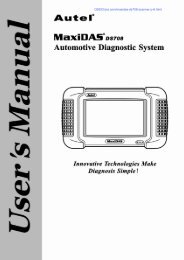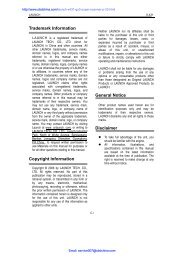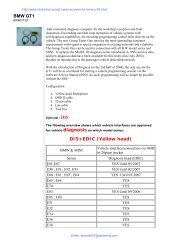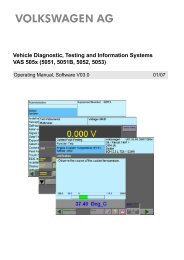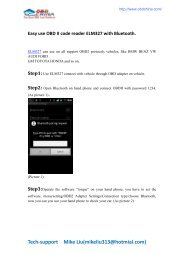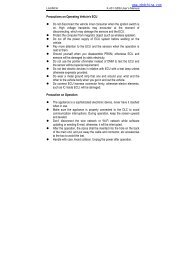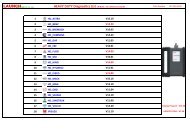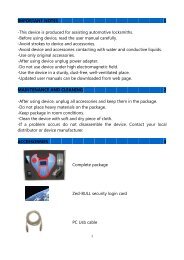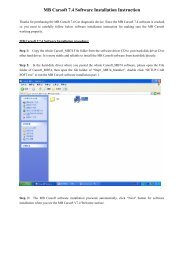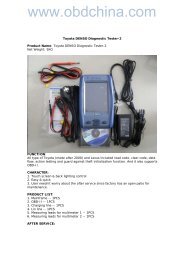Table of Contents - OBD China
Table of Contents - OBD China
Table of Contents - OBD China
Create successful ePaper yourself
Turn your PDF publications into a flip-book with our unique Google optimized e-Paper software.
2. General Information<br />
2.1 On-Board Diagnostics (<strong>OBD</strong>) II<br />
The first generation <strong>of</strong> On-Board Diagnostics (called <strong>OBD</strong> I) was<br />
developed by the California Air Resources Board (ARB) and<br />
implemented in 1988 to monitor some <strong>of</strong> the emission control<br />
components on vehicles. As technology evolved and the desire to<br />
improve the On-Board Diagnostic system increased, a new generation<br />
<strong>of</strong> On-Board Diagnostic system was developed. This second generation<br />
<strong>of</strong> On-Board Diagnostic regulations is called "<strong>OBD</strong> II".<br />
The <strong>OBD</strong> II system is designed to monitor emission control systems<br />
and key engine components by performing either continuous or<br />
periodic tests <strong>of</strong> specific components and vehicle conditions. When a<br />
problem is detected, the <strong>OBD</strong> II system turns on a warning lamp (MIL)<br />
on the vehicle instrument panel to alert the driver typically by the<br />
phrase <strong>of</strong> “Check Engine” or “Service Engine Soon”. The system will<br />
also store important information about the detected malfunction so<br />
that a technician can accurately find and fix the problem. Here below<br />
follow three pieces <strong>of</strong> such valuable information:<br />
1) Whether the Malfunction Indicator Light (MIL) is<br />
commanded 'on' or '<strong>of</strong>f';<br />
2) Which, if any, Diagnostic Trouble Codes (DTCs) are stored;<br />
3) Readiness Monitor status.<br />
2.2 Diagnostic Trouble Codes (DTCs)<br />
<strong>OBD</strong> II Diagnostic Trouble Codes are codes that are stored by the<br />
on-board computer diagnostic system in response to a problem found<br />
in the vehicle. These codes identify a particular problem area and are<br />
intended to provide you with a guide as to where a fault might be<br />
occurring within a vehicle. <strong>OBD</strong> II Diagnostic Trouble Codes consist<br />
<strong>of</strong> a five-digit alphanumeric code. The first character, a letter,<br />
identifies which control system sets the code. The other four<br />
characters, all numbers, provide additional information on where the<br />
DTC originated and the operating conditions that caused it to set. Here<br />
below is an example to illustrate the structure <strong>of</strong> the digits:<br />
2



